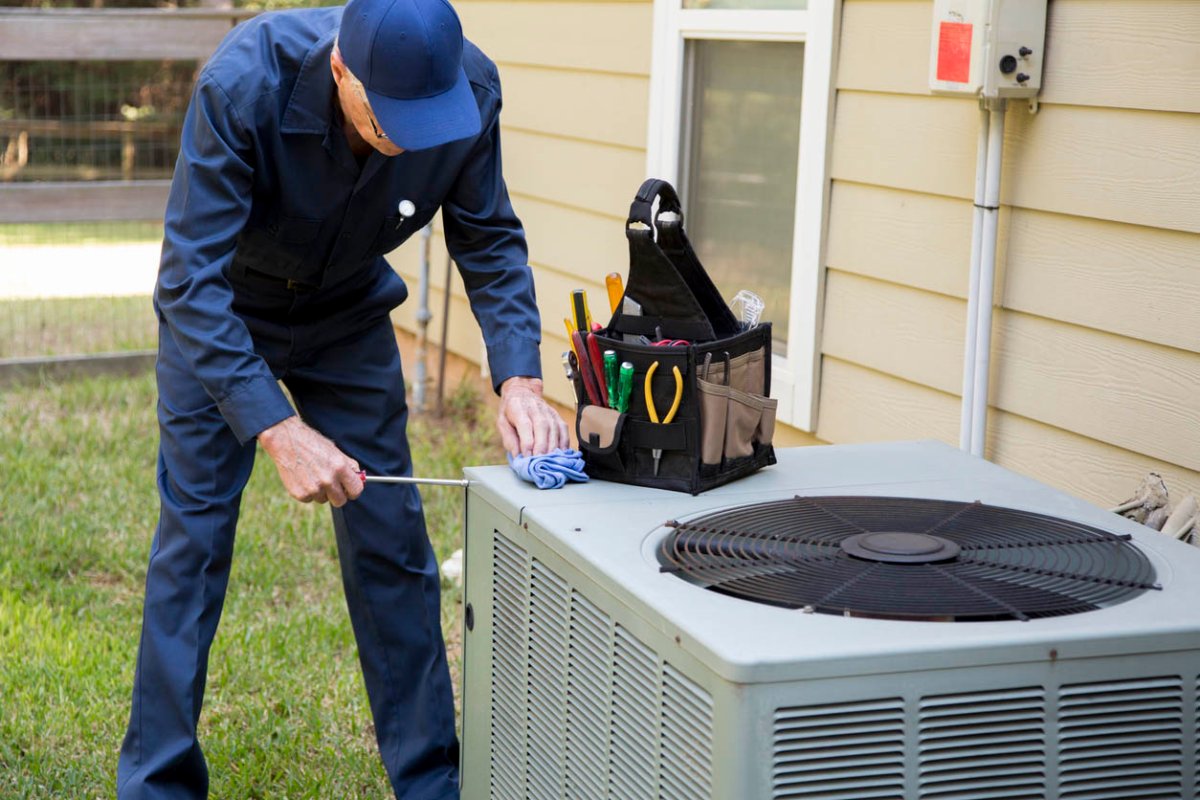

We may earn revenue from the products available on this page and participate in affiliate programs. Learn More ›
Highlights
-
- A central AC unit typically costs between $3,882 and $7,903 to install, with many homeowners across the country paying an average of $5,860.
-
- The final price for AC unit installation will depend on the size and type of the home and the unit being installed, the type of compressor, the unit brand, and the cost of labor.
-
- A homeowner will want to consider AC unit replacement if their current unit is old, creates excessive noise or dust, requires frequent repairs, or if the home is excessively humid or the energy bills have increased inexplicably.
-
- AC unit installation is not a DIY job; since this project requires working with refrigerant and electricity, it’s best suited for a trained and licensed professional.
Air conditioning is considered a necessity in most regions where temperatures can soar during the summer months. If a home’s central AC unit is more than 10 to 15 years old, the energy bill for cooling the home is higher than usual, or the air doesn’t seem as cold as it used to be, then it’s probably time for the homeowner to install a new central AC unit.
So just how much does central AC cost to install? According to Angi and HomeAdvisor, the national average to install a new AC unit is $5,860, with a typical price range of $3,882 to $7,903. Central AC unit costs are determined by a few primary factors: the amount of ductwork needed, the size of the unit, the efficiency rating, and any needed repairs. The benefits of a new central AC unit quickly make up for installation costs, providing homeowners with a more comfortable living space. This guide will cover the main factors that affect central AC cost, the types of AC units, the signs a homeowner might need a new AC unit, and tips on hiring one of the best HVAC companies like One Hour Heating & Air Conditioning or Aire Serv to complete the installation project.
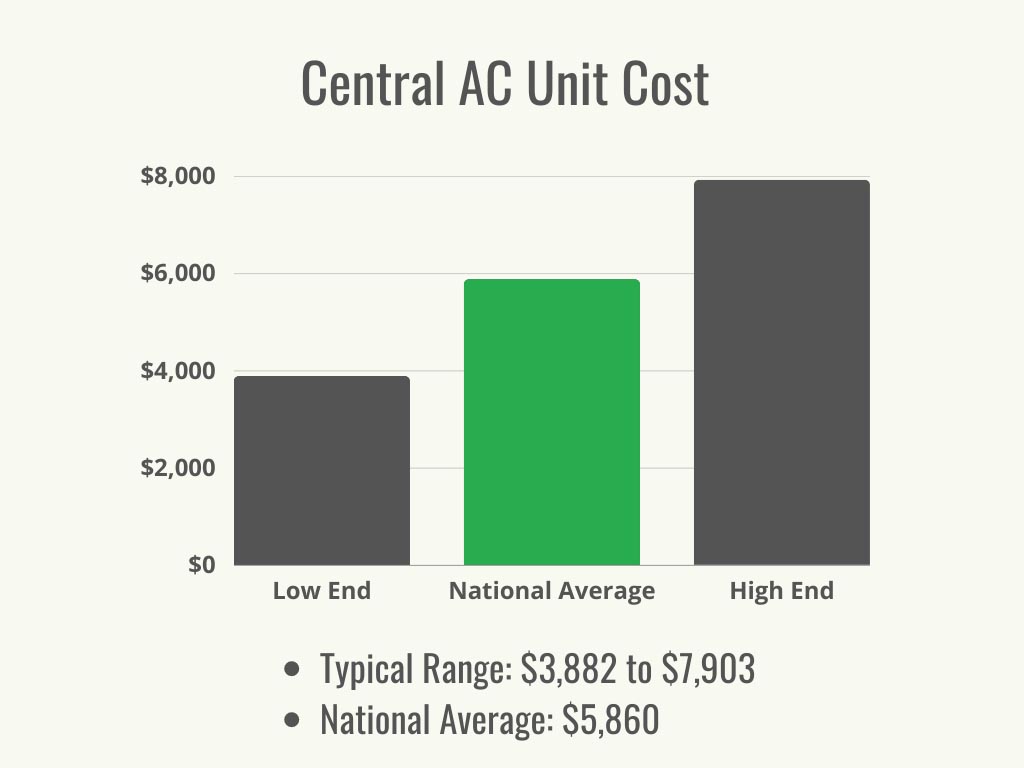
Factors in Calculating Central AC Unit Cost
Central air conditioners are the most popular method for blowing cool air into each room of the house, and the cost to install them varies depending on the size of the house and unit. Installing a central AC unit in an older home may cost more than installing one in new construction. Homeowners may also want to consider the energy-efficiency rating for long-term energy costs.
Home Size
The size of the home will affect central AC installation cost. In general, a central AC unit costs between $2.90 and $7.20 per square foot. Installing a central AC unit in a hotter climate will cost more since a more powerful unit with higher-than-normal efficiency ratings is needed to avoid burning out quickly. A unit with a seasonal energy efficiency ratio (SEER) rating of 16 to 18 will work for most climates. Depending on the SEER rating, a homeowner can expect a cost between $4,350 and $10,800 for AC installation in a 1,500-square-foot home

Home Type
In addition to the size of the home, the type of home will affect AC installation cost. Mobile-home owners will likely need to opt for a ductless mini-split AC unit or a window unit since there typically won’t be space to add ducts to a mobile home. Installing AC units in an apartment building or condo can be expensive, though the cost will likely be lower if the building owner adds AC to multiple units or the entire building at once. Finally, installing a central AC unit in an old house will likely require duct installation as well, which can drive up the price. The following table shows the average installation cost for each type of home.
| Home Type | Average AC Installation Cost |
| Apartment | $57,000 to $180,000 (entire building) |
| Condo | $17,250 to $72,000 (entire building) |
| Mobile home | $3,650 to $7,500 |
| Old house | $8,650 to $22,000 |
Unit Size
When it comes to AC units, bigger isn’t necessarily better. Central AC units measure their output in BTUs (British thermal units) and are typically available in 1.5- to 5-ton capacities. To calculate the AC unit size that they need, a homeowner will want to multiply the square footage of their home by 18 (because it takes about 18 BTUs to cool 1 square foot). If the home has high ceilings, the homeowner will want to multiply the number by 1.25. Then, they will divide that number by 12,000 to get the tonnage required.
For example, a 2,000-square-foot home would require 36,000 BTUs to cool it. Dividing 36,000 by 12,000 equals 3, so this home would require a 3-ton AC unit. The most common sizes are 3- and 4-ton AC units. A unit that is either too large or too small will fail to cool the house correctly, so it’s best for a homeowner to have a technician evaluate their home to determine the correct AC unit size.
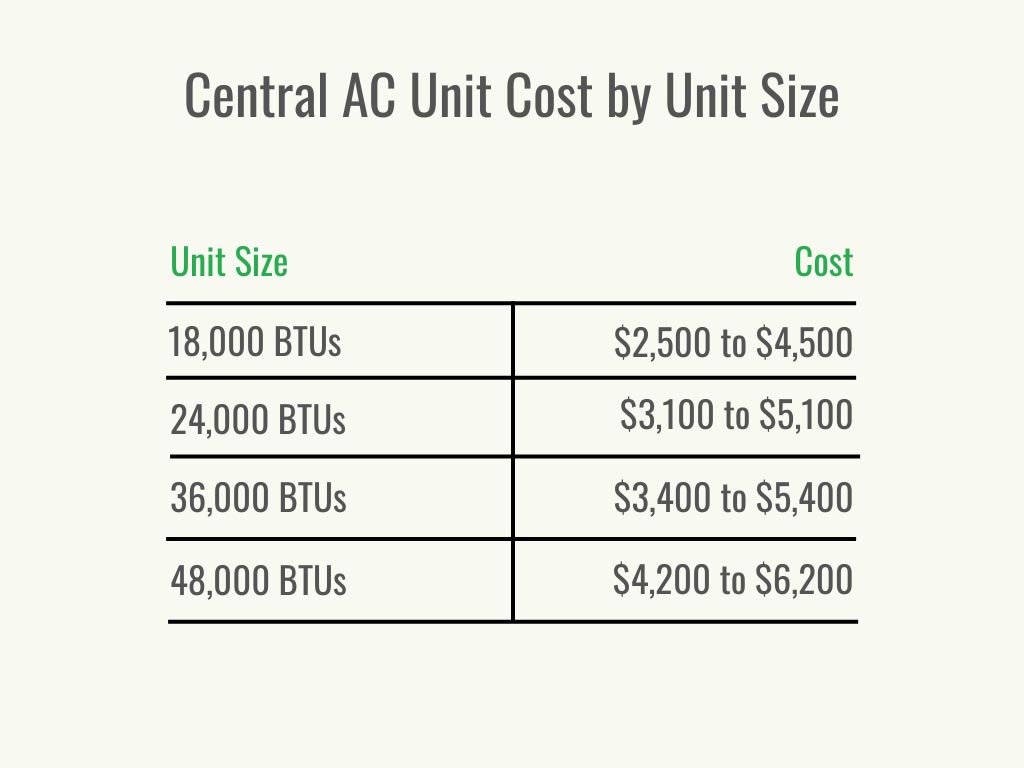
Unit Type
For most regions, a central AC unit is the popular choice to pump cool air to the entire house, and it’s often combined with the heating unit as a complete HVAC unit. If only an air-conditioning unit is needed, professionals can install ductless split systems for an average price of $3,800 to $7,700 (not including labor). If the home has a furnace but not central air, a homeowner can purchase a packaged AC unit system for $4,000 to $8,500 and the technician can install it alongside the existing furnace. Finally, a combined HVAC unit costs between $9,200 to $10,800, but it includes both a furnace and air conditioner in one unit for that higher price.
Compressor Type
When choosing a central AC unit, homeowners can usually choose from among three types of compressor: single-stage, two-stage, and variable-speed. A single-stage AC unit typically has the lowest AC compressor cost, but it’s the least efficient choice as it runs at a single speed at full capacity until the home’s interior reaches the desired temperature. A two-stage unit is more efficient but also costs more than a single-stage unit; this type of unit compressor runs at either full capacity or at 60 percent to 70 percent capacity, cooling the home while using less energy. The most expensive and efficient option is a variable speed AC unit, which can operate at multiple capacities, allowing it to use less energy and therefore have lower running costs.
Unit Efficiency
The seasonal energy efficiency ratio (SEER) rating of an AC unit influences the price and determines how effectively it operates throughout the season. Units with a higher SEER rating may cost more up front, but they’ll have lower operating costs. All modern AC units must have at least a 13 SEER rating per the U.S. Department of Energy. If a home’s AC unit was installed before 2006 (when this requirement was put into place), homeowners will want to consider updating it to take advantage of the new energy-saving efficiency. The average costs for AC units with varying SEER ratings are listed in the table below.
| SEER Rating | Average Cost (Unit Only) |
| 14 | $1,725 to $3,600 |
| 15 | $2,300 to $4,800 |
| 16 | $2,875 to $6,000 |
| 17 | $3,450 to $6,600 |
| 18 | $4,100 to $7,800 |
| 19 | $4,600 to $8,400 |
| 20 | $5,750 to $9,600 |
| 21 | $6,325 to $10,800 |
Unit Brand
The price of an AC unit does not necessarily reflect the total quality. Some of the best air conditioner brands may have the same parts as other brands, but they have a history of product longevity or quality service that bumps up their price. The best AC installation companies in a homeowner’s area can share the features and benefits of brands that work best in that region. Some of the best-known brands and their average prices are shown in the following table.
| AC Unit Brand | Average Cost (Unit Only) |
| Aire-Flo | $1,700 |
| American Standard | $3,200 |
| Carrier | $3,200 |
| Frigidaire | $2,900 |
| Goodman | $2,100 |
| Lennox | $3,400 |
| Trane | $3,300 |
| York | $2,800 |
Labor
Total central AC unit costs are strongly influenced by installation costs, which vary from one project to the next. If a new unit needs to be installed without updating existing ductwork, labor costs have a lower average of $1,250 to $3,000. For complete ductwork and unit installation, most homeowners spend an average of $2,215 to $5,325. The actual unit is an additional cost, and the price depends on the type of unit.
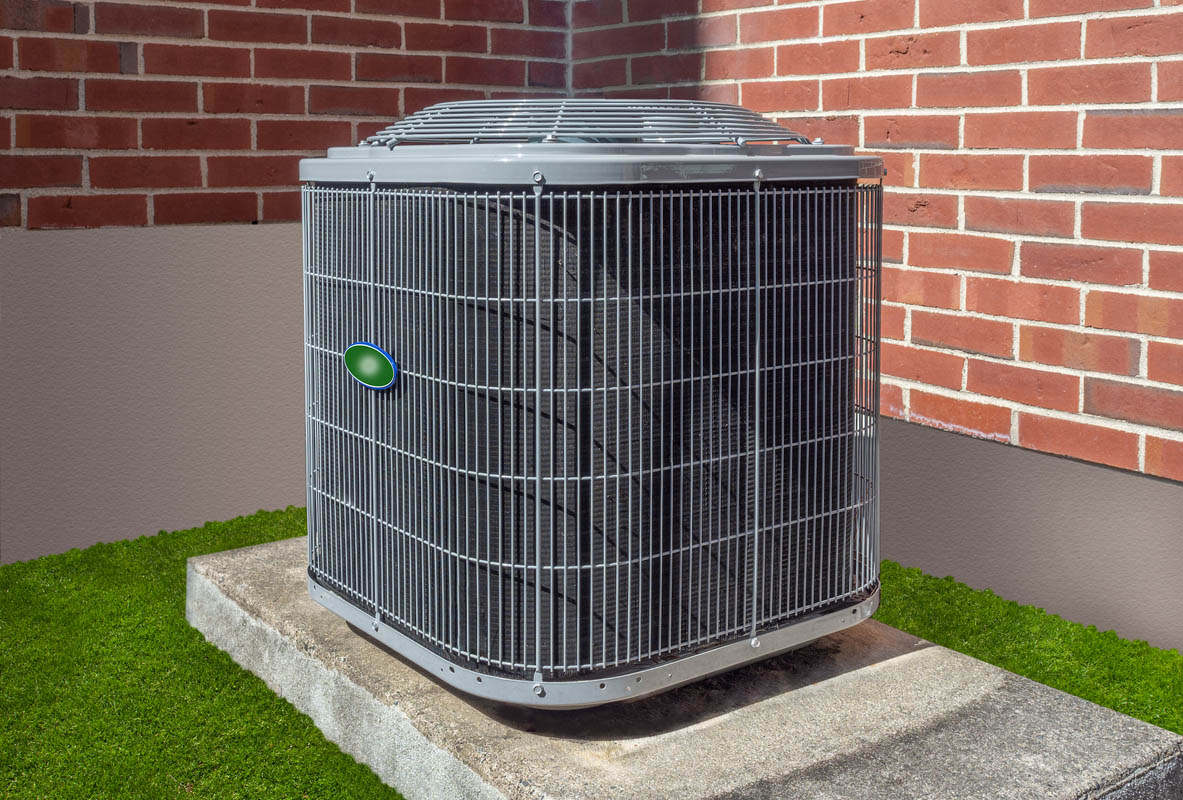
Additional Costs and Considerations
New construction usually has the most straightforward central AC unit costs, but sometimes homeowners need to upgrade an old unit that’s reached the end of its lifespan or install a new one altogether. In these cases, the total cost is affected by different situations that may or may not apply. Additional plumbing, electrical work, the removal or repair of existing HVAC systems, mold testing, asbestos removal, and other factors can increase the cost to install central AC.
Zones and Controls
For larger homes, a multiple-zone air-conditioning unit might be the best choice to control uneven heat distribution adequately. Some rooms or areas of the house may collect and retain extra heat if exposed to more sun. Cooling only these areas more frequently using a zone system helps prevent other rooms from receiving arctic blasts of air too often. Adding more zones and controls will increase the price but may make the house more comfortable overall.
Ductwork Installation or Repair
Existing ductwork may not handle the increased airflow of a new AC unit and could require replacement. The cost to install new ductwork ranges from $1,100 to $2,700. Leaky ductwork can also be the culprit of an air-conditioning unit that doesn’t cool like it used to. Over time, ductwork can deteriorate, so it’s always a good idea for a homeowner to have it inspected if they suspect a problem.
Plumbing
Adding central air to a house means plumbing lines will need to be installed. All central air units need a drain line as condensation builds from the air handler. This helps prevent water damage. This installation will add to the cost, as will any necessary repairs to existing damaged plumbing lines. The average cost to install plumbing for a new AC unit ranges between $100 and $150.
Electrical Work
The central AC unit requires electricity from a hard-wired, dedicated circuit. A standard 240-volt connection is required, and depending on the size of the AC unit, it’ll require between 15 and 60 amps of power. A homeowner will need to hire an electrician to install this outlet and update your circuit breaker. A new electrical circuit will cost between $100 and $150 on average.
Existing HVAC System Removal
Removing an old unit is relatively easy, and some companies will remove it for free when they install the new system. Disposal fees typically average $25 to $200, depending on how old the system is. Removing and upgrading ductwork will increase the price since it could be a time-intensive task.
Home Modifications
If a homeowner is adding a new room or changing the height of large spaces (like adding a vaulted ceiling), they’ll need to update their central air system. New ductwork and vents will be installed at a minimum, but a larger unit may also be required to cool the entire house adequately. A pro can help a homeowner determine if the existing unit in the home will be sufficient for the modifications.
Mold Testing and Removal
If the AC smells musty, mold could have contaminated old and damaged ductwork. Homeowners will want to use a mold specialist company to do certified testing. Improper cleaning methods can damage fiberglass and flexible HVAC ductwork, so homeowners will need to get a qualified technician to safely remove the mold without exposing the rest of the house.
Asbestos Testing and Removal
A phrase that many homeowners dread hearing is “asbestos removal,” but if asbestos fibers are found, then it’s best to get them removed as quickly and safely as possible. Hiring an asbestos removal company is the right move for a homeowner to make when dealing with asbestos in their ductwork. These professionals will be able to identify if the asbestos can be encapsulated or if the ductwork will need to be replaced entirely.
Permits
Since clean and adequate airflow is critical for humans, air-conditioning system installation is regulated, and professionals must obtain proper training and licensing. AC units use refrigerant to cool homes, and professional installers are trained to handle any contamination or accidental spills. Homeowners will want to review the installation contract to understand what local and federal regulations apply to avoid potential fines for improper installation.
Warranties
Most central air conditioners include a manufacturer’s warranty that lasts between 5 and 10 years. Warranties generally cover parts and equipment, but the installer may also offer a warranty for labor on repairs that fall within a specific period. Extended warranties might also be available, but at $100 to $500, these often cost more than any standard repairs that could occur over the lifespan of the AC unit. A warranty can come into play if a homeowner notices that their AC unit fan isn’t spinning or their outside AC unit is not turning on.
Homeowners might also want to consider getting a policy from one of the best home warranty companies for HVAC , such as American Home Shield or Liberty Home Guard. A home warranty can provide coverage for whole-home systems, like AC units, as well as major appliances, if they sustain damage as a result of normal wear and tear. Rather than paying the full price for repairs, the homeowner will simply call their home warranty provider and pay a service fee for a technician to come to their home and inspect the unit. If it requires repairs, the home warranty may cover the HVAC system—and in some cases, the warranty company may pay the entire cost to install a new HVAC unit.
Cost by Type of Unit
When it comes to installing a whole air-conditioning system, as opposed to small window units, there are two types of AC units you can choose from. Central air conditioning with ductwork is the most popular choice for homeowners who are ready to install a complete HVAC system to maintain a comfortable temperature throughout the year. A ductless split system is another excellent choice that can be installed in specific rooms without ductwork—even if a heating system is already installed in the house.
| Unit Type | Average Cost |
| Split system | $3,800 to $7,700 |
| Packaged AC system | $4,000 to $8,500 |
| Packaged HVAC | $9,200 to $10,800 |
Split System
Ductless split systems use a condenser and compressor unit installed outdoors and an evaporator installed indoors. Sometimes this indoor evaporator is already used to heat the house. The more zones a homeowner wants to cool, the more this system will cost. Ductless systems are faster and easier to install since ductwork doesn’t have to be installed throughout the walls or attic. Homeowners can expect to pay between $3,800 and $7,700 for a ductless split system AC unit.
Packaged AC System
A packaged AC system can be installed if the home currently has a furnace but no central AC. Using the same ductwork as the furnace, a packaged AC system pulls air from large areas of the house, filters the air, then cools it before blowing the cool air back into the house through the ductwork and vents. Most air filters need to be replaced every few months to ensure the system can flow clean air into the home without stirring up excess dust or allergens. The average cost of a packaged AC system is $4,000 to $8,500.
Packaged HVAC
A packaged HVAC system is the best option for a new build or for a home with an aging furnace that will soon require replacement. A packaged system is an exterior unit that provides both heat and cooling to the home, and therefore requires less ductwork, which can be a benefit if the home does not have ductwork or if the existing ductwork is old and needs to be replaced. A packaged HVAC system costs between $9,200 and $10,800.
Do I Need a New Central AC Unit?
Spending several thousand dollars on a major home system isn’t the easiest pill to swallow, but there are several reasons why adding central air to a home, or replacing an aging system, is a good idea. Central AC units eventually wear out just like any other mechanical equipment. An older unit will need to be replaced to regain energy efficiency, improve cool air output, reduce humidity, and more.
AC Unit Age
If the home has an older AC unit, the time will come when it will fail. How long do HVAC systems last? Most central air-conditioner systems have a lifespan of 15 to 25 years, depending on the type of unit. Without proper maintenance, like changing air filters or having it serviced regularly, it may wear out sooner. Older units are also less efficient than newer models, so the quality of cool air may significantly improve with installing a new unit. It’s usually worth homeowners paying an annual HVAC service cost to help increase the likelihood that the unit will reach the top end of its anticipated lifespan.
Unusual Noises and Excessive Dust
When an AC unit grows noisy, that usually means it has outlasted its prime or that it has a ductwork problem. Noises may result from ductwork that is not large enough to handle the square footage of the house or from an inner coil that has worn out. Constantly finding dust around the house is another indicator that there is leaking ductwork.
Increased Utility Bills
Some summers are hotter than others, but if a homeowner has noticed a much higher energy bill than usual, their AC unit may be working harder but less effectively. Typically, a homeowner will see a sudden spike from one month to the next. The motor and other parts may not operate at the same capacity as before, so the system runs more often to compensate. Replacing the central AC unit will likely solve this problem.
Excessive Humidity
AC units are designed to remove excess humidity, which is typically associated with a warmer sensation. If a homeowner notices more humidity in their house than expected, they may want to have their central AC system inspected to see if it needs repair or replacement.
Frequent Repairs
If a homeowner is constantly calling an HVAC expert for repairs, such as if their central AC is not blowing cold air, it’s probably a good idea for them to get a quote for a new unit. While warranties help cover AC repair costs, they don’t last forever. If an expensive repair hits just after a warranty expires, the homeowner will need to consider whether it’s better to simply replace the unit. Homeowners can multiply the total cost of repairs by the age of the system to help them decide if it’s time for a replacement. If the amount is more than $5,000, the homeowner will want to start looking into HVAC unit replacement costs.
Home Selling
A broken-down or worn-out AC unit can be a significant deterrent for prospective home buyers, especially in hot climates. Replacing an old central AC unit is an almost invisible update that positively impacts a home’s value—not to mention a homeowner’s own comfort. If the home is located in a climate where AC isn’t a necessity but a luxury, installing a split system might appeal to more potential home buyers who would like to have the option.
Home Improvements and Additions
The type of cooling system a homeowner selects will depend on the area that needs to be cooled. Adding new rooms will require an update to ductwork and potentially a new AC unit. If the cooling system is too small to handle the addition, it will run more frequently, reducing its lifespan and increasing the homeowner’s energy bill. Whether a homeowner is building a garage apartment or knocking out a wall to combine their kitchen and dining room, it’s smart for them to consider the impact on their cooling system.
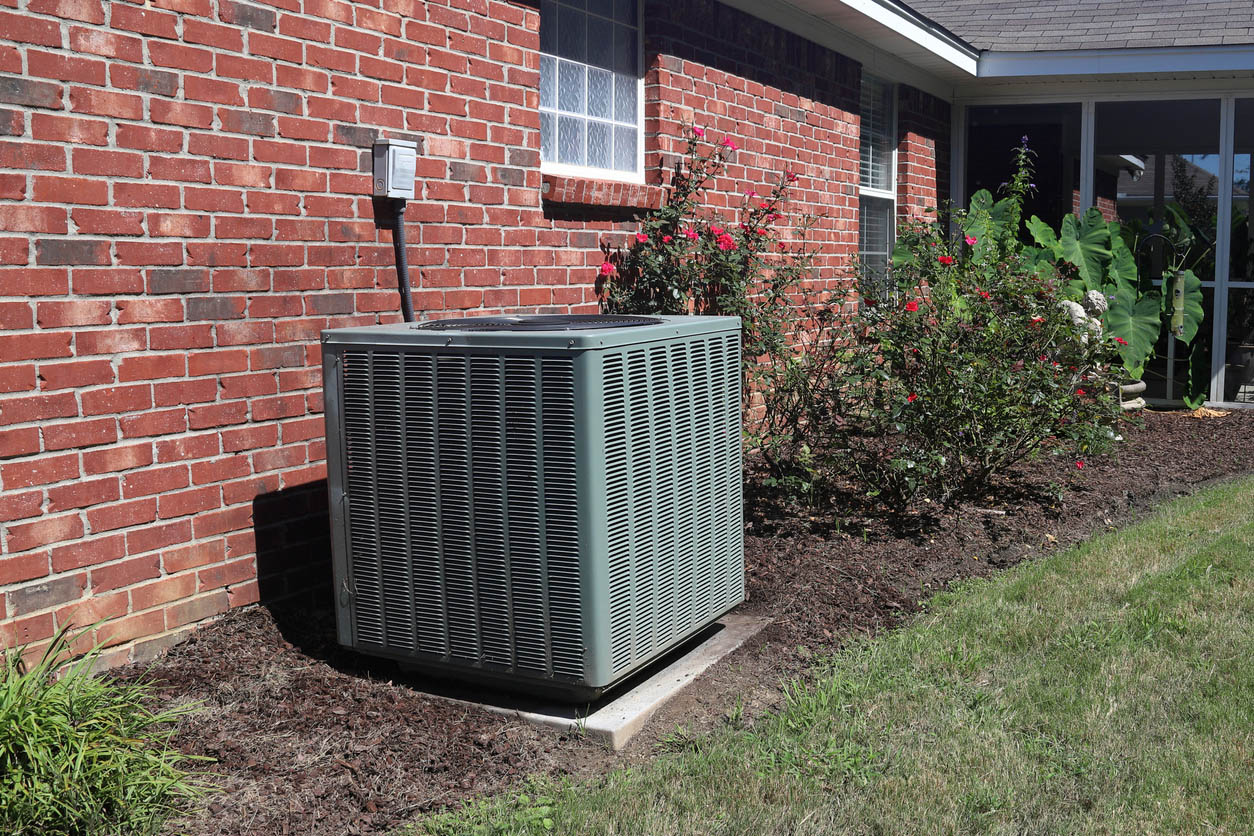
DIY vs. Hiring a Professional
Installing a central air-conditioning unit is not the most glamorous way for a homeowner to spend their hard-earned money, but a fully functioning AC unit is certainly one of the most comfortable necessities in some regions. It can be tempting for a homeowner to wonder if they could install their own AC unit to save on costs, but this is one area that’s not advised for a DIY project unless the homeowner is already licensed to do so. Cooling systems use chemical refrigerants to instantly cool air in a home. Older units may still use Freon, which is a type of refrigerant that has been banned since January 1, 2020, due to its damaging effect on the earth’s ozone layer. Only trained and licensed technicians are allowed to handle this chemical and must dispose of it properly.
Professional installers can adequately measure the home to determine the best ductwork layout and unit size to cool it to a comfortable temperature. They’ll also know how to install ductwork properly to avoid leaks and to ensure each room gets adequate airflow. Overall, it’s a small price for a homeowner to pay to ensure the safe installation of a long-term benefit for comfortable living.
How to Save Money on a Central AC Unit
Central AC unit costs can feel overwhelming. The cost to install a central AC unit in a new house is less daunting since central AC unit costs are typically built into the project in most areas. No matter which situation applies, here are some ways to save money on AC unit installation costs.
- Research tax rebates. Look for local and federal rebates and tax breaks for upgrading an old system to a newer high-efficiency system.
- Install in the off-season. Consider installing an AC unit in the spring or fall when HVAC professionals are less busy.
- Consider a mini-split. Ask about installing a ductless split system if you prefer to cool only a few rooms in the house.
- Save on energy bills. Replace an old central air-conditioning unit to save on monthly energy costs.
- Keep up with maintenance. Frequently maintain the central air system to extend the lifespan and deter significant repairs.
- Ask about discounts. Many AC installation companies will offer sales and discounts for customers around certain holidays, so it’s worth asking to see if you can decrease the cost of installing your new AC unit.
- Shop around. It’s generally recommended to obtain more than one quote—ideally at least three—to find the best deal for the best system for your home and price range.
Questions to Ask a Pro
Fortunately, installing a new central air-conditioning system doesn’t have to be a complicated process when working with a pro. An in-person consultation will help the technician understand the homeowner’s needs and map out the best system. To feel more comfortable discussing their project, homeowners might consider asking any of these pertinent questions about central AC unit costs.
- Are you licensed and insured to install a cooling system?
- How long have you been in business?
- Is a central air or ductless split system best for my needs?
- What size or capacity of an AC unit do you recommend for my house?
- If I already have ductwork installed, can it be used with a new unit?
- Will you inspect my existing ductwork for leaks, mold, and asbestos?
- How much will it cost to remove my old AC unit?
- What kind of upgrades or smart tech is available for new AC units?
- What is the SEER rating of the AC unit you recommend for my house?
- How much will I save on energy costs each month?
- Which brands do you recommend for my region and why?
- Are there any local or federal rebates available?
- What kind of warranties or guarantees are available?
- How long will it take to install this central air system?
- What kind of maintenance will this system require?
- Can I do any maintenance myself?
- How long will this system last?
FAQs
Even if a homeowner has read a lot of information about central AC installation costs, they may still have a few questions. The following are the answers to some of the most commonly asked questions to help homeowners’ understanding of this project.
EER (Energy Efficiency Ratio) is the standard measurement of energy efficiency for cooling systems throughout the year. It’s calculated by dividing the BTUs by the rate of energy input in watts. It’s a calculation that’s used more by manufacturers than homeowners.
SEER is how an AC unit’s energy performance is measured during the season used, typically when outdoor temperatures range from 65 to 104 degrees Fahrenheit. The cooling output is divided by the electric input to determine the rating. A higher rating is more efficient, and a minimum rating of 13 has been required on all models since 2006. Central air units that operate at a 13 SEER can boost efficiency by up to 30 percent.
Determining the proper size AC unit for a house is not a cut-and-dried process, so homeowners will want to have their house evaluated to find out the best option. A 3-ton AC unit is a common size for many homes.
Regular maintenance can have an effect on how long an air conditioner will last. Homeowners will want to make sure they replace the air filters every few months to prevent the system from overworking to draw in enough air to operate correctly. Additionally, it’s advisable to cover the outdoor AC compressors during the winter. In the spring, homeowners will want to open the units and clear away any debris before turning on the AC. Additionally, they can gently spray or clean off the fans and inner fins to ensure they can operate smoothly with all the airflow they need. It’s also a good idea for a homeowner to inspect the compressor to make sure it’s level. Settling soil or tree roots can tilt the compressor and affect its ability to operate correctly. Homeowners can also have these tasks performed by a professional HVAC technician—HVAC inspection costs around $300 on average.
The size and scope of a project dramatically affect how long it will take to install a central air conditioner. On average, it takes 1 to 5 days. Replacing a unit will take less time than replacing or repairing ductwork. It may take longer to install or upgrade an AC unit during a home addition if the ductwork is extensive or if a new unit and controllers also have to be installed.
Angi, HomeAdvisor, Fixr, HomeGuide, IWantSmart.com
